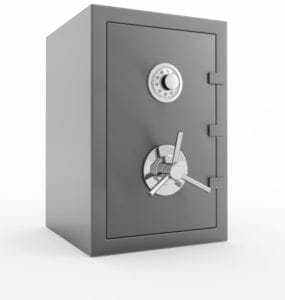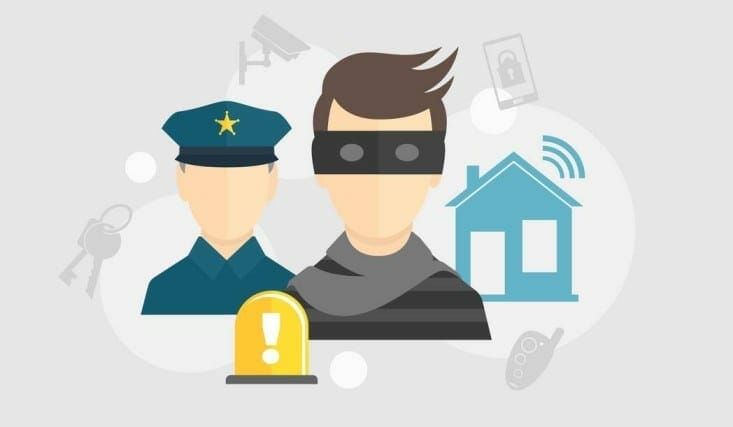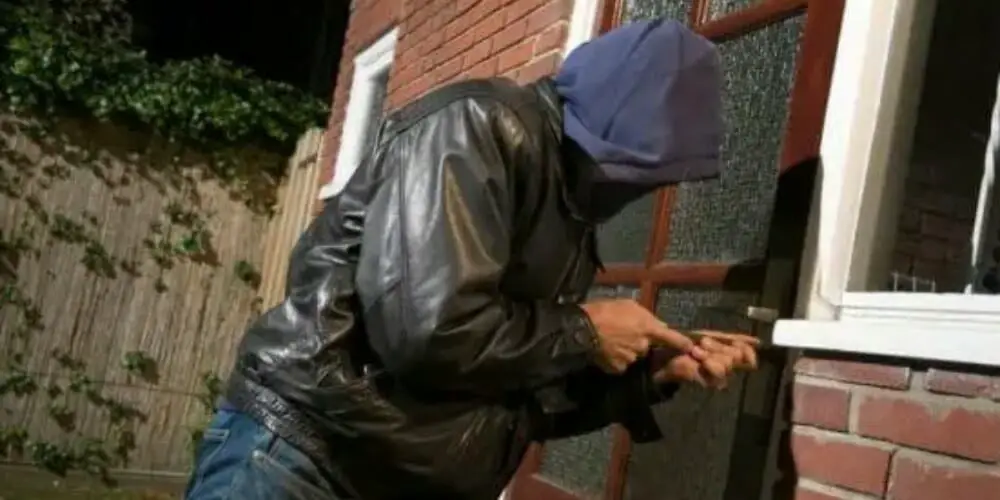You should feel safe inside your home when your doors are locked and the blinds are drawn. However, a quick look at home burglary statistics can put things in perspective and make you realize you’re not as protected as you think.
Burglars don’t just pick homes at random until they meet a quota – they strategically choose which places they have the best odds of successfully breaking into.

By learning burglars’ secrets and burglary statistics, save yourself from becoming just another break-in. Strapped with this kind of knowledge, you’ll be able to create a safe and secure home that burglars won’t ever want to mess with.
We’re sharing all the data and secrets of home burglaries so you can stay protected. We’re covering it all -from state-to-state data, points of weakness, likely targets, and the burglar mindset.
After discussing how burglaries work, we’ll also learn how to prevent them. Simple tricks can decrease your chances of experiencing this kind of break-in.
Safeguard your “safe place” with this home security knowledge.
Burglars: Who They Are
Burglars tend to fit a certain bill. While you never want to assume someone is looking to commit a crime based on how they look, these are the demographics that represent a majority of burglaries:
- Males under the age of 25
- Motivating factors include drug use and money
- More likely to commit property crime during warmer months due to weather implications
- More than half of burglars live within two miles of their victims and likely know who lives there.
- They are likely not looking for violence and aren’t using a weapon
- They’re more likely to strike quickly during the daytime as it is less suspicious
- Don’t expect a team or even partners – they usually work alone
- It’s not usually their first offense – they may have a criminal history of robbery, selling drugs, or assault
- It can range from being their first crime, an amateur attack, or a criminal profession

What exactly is a professional burglar? These folks can support themselves entirely from the money they steal or selling their stolen items. They know what they’re doing and approach each burglary with a plan. Often, they’ll scout the area several days in advance and study the residents closely before deciding to commit the crime.
An amateur burglar, on the other hand, is an opportunist. These are the criminals more likely to make a move impulsively. If they see a property that looks prime for burglary, they might move right then and there.
Weak Spots Burglars Look For

While it’s impossible to get inside the mind of a burglar, we can use what we know about break-ins to identify the weak spots and characteristics burglars look for when they choose a mark. By auditing your home for any of these aspects, you can minimize your risk of falling victim to a burglary.
Regardless of any given burglar’s experience, they’re all looking for the same things when looking for a house to target.
If they’re going to put in the effort to break in and steal, they only want to do it to a house that will be worth it. Ideally, they’re looking for minimum effort with maximum reward.

Of course, they’re ideally looking for homes that appear to have lots of valuables inside. They also prefer a place that is empty at the time of entry.
Here’s a comprehensive list of the major indicators a burglar looks for when choosing a home to break into:
- Homes without security. When someone sees security systems signs or security cameras around your house, they realize they’re being surveilled. They know they won’t be able to get in and out without being seen, so it’s usually not worth the risk to even try.
- Empty homes. If you have mail stacked up in the mailbox and no lights on, that’s a good indication that you’ve been gone for a while. Even if you’re just out for the workday, small signs that suggest an empty house make a target even more attractive.
- Homes in wealthier neighborhoods. Of course, wealthier neighborhoods are assumed to have more valuable items inside their homes. Unfortunately, living in these communities makes you more likely to experience a break-in.
- Homes with neighbors on both sides rather than corner lots. On both sides, a corner lot is much more vulnerable than a covered home.
- Homes with concealed entry. Remember that these are great for burglars if you have overgrown shrubs or large trees that conceal windows or doors. Keep everything trimmed and easy to see.
- Homes with expensive cars in the driveway. Garages are a good idea for a reason. If you have an expensive car, keeping it behind closed doors will keep burglars from picking your house out of the row. When they see a luxury vehicle, they assume the residents have other items.
- Homes with pet doors. Even though your doggy door might make life easier for your pet, it’s also an unprotected entrance into your home. Even a small opening like this could allow a burglar to enter without breaking in. If you have pet door guards, securing them when you leave the house is a good idea.
- Homes with open garages. Just because the door within your garage is locked doesn’t mean you should leave your garage wide open.
- Homes with hidden keys. Leaving a key under a rock or doormat is helpful when you lock yourself out. However, it also helps a burglar get into your home with ease. There are better systems to keep your home accessible to you. Things like keypads on the doors are a good way to keep burglars out.
- Homes with doors that have windows. If your door has a window, a burglar might take the opportunity to peek inside and see if there’s anything worth taking. When valuables are in sight, you become a great target.
- Homes with flimsy doors. Did you skip spending the extra money to get a solid core door? It’s worth investing in something more sturdy, as flimsy doors make it much easier for someone to break in with minimal effort.
Did reading through this list make you realize how many weak spots you might have in your home? Homeowners don’t think about many of these things until it’s too late. By minimizing the number of weak spots, you’ll also minimize your chances of falling victim to property crime.
Surprising Burglary Statistics
The list above probably made you realize how little you know about home invasions. This article aims to educate homeowners about property crime’s realities. In doing this, we hope residents can strengthen their home security.
Now that you’ve come to terms with the weak spots of your home, it’s time to face the music about burglaries:
The average victim of home burglary will lose $2,416. That can be two months’ rent or a few weeks of income for most people. If you’re relying on each paycheck, you receive, that’s a big blow. This amount comes either from actual money stolen or valuable items stolen.
The first place a burglar goes inside the home is the bedroom. Why? That’s where most people keep their valuables. If you’re in a two-bedroom home, they’re likely to completely bypass the first floor and head upstairs to the bedrooms.
Some people think TVs and electronics in the living room are more susceptible, but that’s not the case. These items are large, bulky, and hard to disguise. Rather than figuring out the logistics of fitting a plasma TV in their getaway car, it’s much easier to go for cash or jewelry.
Keep this in mind: they will want to take it if it’s small enough to fit in their pocket. These items won’t draw any attention from neighbors or passers-by.
You can disappoint burglars by keeping your valuables somewhere else besides your room. An unlikely stash spot? The pantry or freezer. The best idea, however, for true valuables is to keep them in a bolted safe or safety deposit box at the bank.

Burglaries in the United States are decreasing.
- Alas, here is a bit of good news! From 2008 to 2017, burglaries in the US decreased by a whopping 37%. In addition, property crimes, in general, have dropped about 69% since the 1990s.
What caused this? Experts believe it is due to the increased alarm systems in residential homes. Over the years, they’ve become more available and less expensive. Families are taking advantage of this and arming their homes. So far, it’s proven to help!
One burglary occurs every 23 seconds in our country.
- Even though the rates are down, they still aren’t great. That equals over 1.3 million burglaries each year. Burglary is still the 2nd most frequently occurring crime right after larceny-theft. Just because you hear about burglaries happening to other people does not mean it won’t happen to you. That perspective will only make you more susceptible to these property crimes.
You’re more likely to get burglarized in rural areas than in urban areas.
- Even though cities like Los Angeles, Chicago, and New York are known for their crime rates, they’re at the bottom of the list for burglaries. The most burglarized states in the US are New Mexico, Mississippi, Louisiana, Arkansas, and Oklahoma. These southern and midwestern states attract more break-ins than any city does.
This could be because a much higher concentration of people in cities makes it harder to break it home undetected. Rural areas have large stretches of land between homes, making it easier to get in and out without being spotted. This could be because there’s a much higher concentration of people in cities, making it harder to break into homes undetected.
A burglar is more active during the warmer months.
- Just as residents enjoy the summer for all its outdoor activities, burglars enjoy it for the opportunity to steal. June, July, and August have the highest number of burglaries out of the year. With more daylight hours, burglars have more time to strike. The weather is also nice, so they won’t have to worry about sneaking around during the cold.
A burglary is much more likely to occur around midday.
- While many think a criminal covets the shade of night, that’s not the case. The most common hours for a burglary are between noon and 4 p.m. Nighttime invasions only account for 17% of all burglaries. Think about it – a burglar walking around the neighborhood scouting for marks is much less suspicious during the daytime than they would be at night. Plus, the majority of people are gone during the work day. This leaves homes empty and vulnerable.
A third of robberies don’t even require a break-in.
- There’s a difference between forcible entry and unlawful entry. A forcible entry means they had to break in. An unlawful entry means they came in through an entrance that was unlocked.
A suburban home is more likely to get robbed.
- Suburban areas have less traffic and often much more space around homes. More space allows the thieves to identify entry points and hiding spots. Less traffic minimizes the chance of someone seeing. If you live in a single-family suburban home, it’s smart to stay vigilant about home security.
The Odds: Against Or In Your Favor?
What are the chances of your house being robbed? Are the odds of home burglary in your favor? Or are they working against you?
Aspects like weather, location, neighborhood type, and time of day come into play when determining what houses are more likely to be burglarized.
Find out where you stand on the spectrum of security with these fast facts about the odds of burglary:
- In 2015, 72% of burglaries happened in residential homes.
- The ten states with the highest risk of burglary include Mississippi, New Mexico, Nevada, Arkansas, Louisiana, North Carolina, South Carolina, Oklahoma, Alabama, and Washington.
- The ten states with the lowest risk of burglary are New York, Virginia, New Hampshire, Connecticut, Vermont, Pennsylvania, New Jersey, Massachusetts, Wyoming, and Nebraska.
- Areas with a higher population density tend to have fewer break-ins.
- States with colder, harsher climates tend to have fewer break-ins.
- If you live in these cities, you can rest easy knowing you have some of the fewest burglaries: Palatine, IL; Orland Park, IL; Fishers, IN; Carmel, IN; Peabody, MA; Leesburg, VA; Novi, MI; Rochester Hills, MI; Ramapo Town, NY; and John’s Creek, GA.
- If you live in these cities, you might want to lock up tight. These cities have the most burglaries in the US: Lake Charles, LA; Youngstown, OH; Springfield, OH; Canton, OH; Dayton, OH; Pueblo, CO; Vallejo, CA; Santa Fe, NM; Memphis, TN; Albany, GA.
- Cities that share the traits of lower unemployment, small populations, and higher education
- Burglars engage in crime mainly for drugs, money, thrills, or revenge.
- They’re most excited to find cash, drugs, jewelry, electronics, and expensive clothing when breaking in. When they find money, they spend it on drugs, partying, gambling, clothes, gifts, and bills.
- Burglars are hoping for easy targets. Homes are the easiest to break into, with businesses coming in second.
- It’s typical for them to case your house before the attack. However, most are looking for a quick target that they can get within 24 hours.
- Do you live in a rental? You’re more likely to get broken into than folks that live in a home they own. This might be because renters don’t often have the kinds of security systems owners can install.
- If a burglar is planning to steal from apartment buildings, they prefer one with four units or fewer. More than that increases the risk of someone seeing.
- A typical break-in and burglary don’t last much more than 10 minutes.
- In nearly 30% of burglaries, a resident is a home.
- The southern region of the US makes up 47% of all burglaries.
- Police have trouble solving burglaries. In 2015, they only arrested about 13% of cases.
- It’s likely the burglar knows the victim personally or is at least able to identify them.
Tips to Scare Them Away
Just because the area you live in or the type of home you have makes you more likely to experience a burglary, it doesn’t mean you have to have one. Luckily, there are many ways to strengthen the security of your home and decrease your risk. According to a survey of criminals convicted of the crime, here’s exactly what they’re looking to avoid:
Big dogs. Of course, the best living security system you can get is a guard dog. Breeds known for their loyalty and protection include Rottweilers, German Shepards, Dobermans, Mastiffs, Pit BIlls, Boxers, Rhodesian Ridgebacks, Great Danes, Saint Bernards, Irish Wolfhounds, and Labrador Retrievers. These dogs can be trained to be loving and sweet to their owners but protective against strangers. Even if you don’t have a big dog like this, you can make it seem like you do. By placing Beware of Dog signs and leaving out a decoy dog bowl or bone, an intruder might decide to skip your home altogether.
Cameras. A video camera is a burglar’s worst enemy. With so many burglaries going unsolved, cameras provide incriminating evidence with video footage of the crime. Doorbell cameras are especially deterrent, as that’s usually the first area they check for an unlocked door. If they think they’re being recorded, they won’t want to get near your house.

Neighbors. If you’re going out of town, be sure to let your neighbors know and ask them to keep an eye on things. If they’re able to collect your mail each day, that’s even better. Stacked-up mail in the mailbox is a dead giveaway that residents are out of town. Active neighborhoods with children playing and adults walking around or talking to one another can dissuade a burglar from choosing your neighborhood altogether.

Lights. Keeping your lights on inside will create the illusion that someone’s home. If you leave the lights on for days at a time while you’re away, that will create the opposite effect. If you travel often, you might want to consider installing specialty dusk-to-dawn lights that come on and shut off on a timer to mimic your presence.
Solid doors. Heavy metal or solid wood core doors make it that much harder for someone to break in.

Law enforcement associations. If a burglar has any reason to believe you’re associated with law enforcement, they’ll stay far away. You can give off this illusion by purchasing Sheriff’s Office stickers and placing them on your cars or windows.
Motion lights. If a burglar is sneaking around your house and trips your motion-detecting lights, they’ll freeze in their tracks. Motion lights signal to the bad guys that their movement has been detected.
Smart locks. A smart lock or smart doorbell that can be connected to your phone is a great security measure. Criminals recognize these models and know that the owner can usually control the lock and even see who’s there remotely.
Low gates. While tall fences can provide burglars with coverage while they break in, a low gate in the front has the opposite effect. Remember that these criminals are looking to get in and out as fast as possible. With a gate in their way, it’s just one more obstacle they have to cross.

Wrapping Up
It’s always better to be safe than sorry when it comes to property crime. Taking extra measures to protect your home – things like a guard dog, home security system, or motion detection lights – can greatly decrease the chances of someone breaking into your home and burglarizing it. Take the tips and burglary statistics shared above to protect your family and home from unwanted visitors.
Learn something new? Share this article and spread the knowledge in the grand scheme of burglaries, that accounts for just 17%. The chances of being broken into at night are very low.

